1. 二叉树之层序遍历
1.1 144-二叉树的前序遍历
144
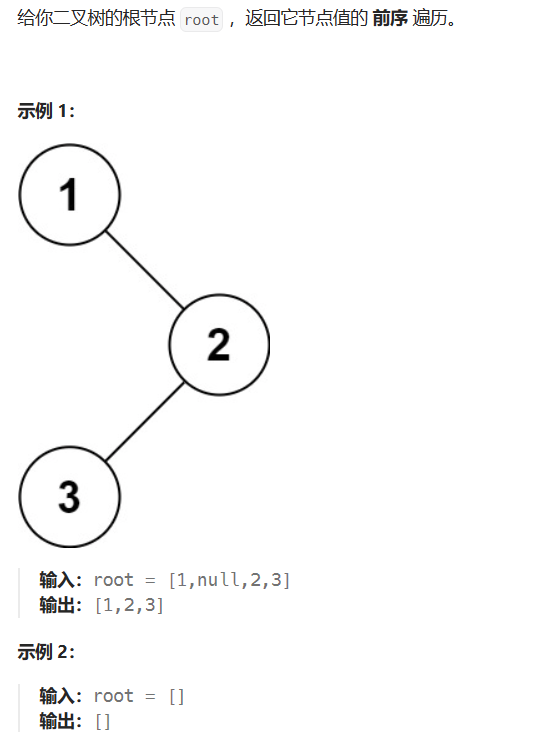
1
2
3
4
5
6
7
8
9
10
11
12
13
14
15
16
17
18
19
20
21
22
23
24
25
26
27
|
class Solution {
public:
void Recursion(TreeNode* root,vector<int>& ans)
{
if(root == nullptr)
return;
ans.push_back(root->val);
Recursion(root->left,ans);
Recursion(root->right,ans);
}
vector<int> preorderTraversal(TreeNode* root) {
vector<int> ans;
Recursion(root,ans);
return ans;
}
};
|
迭代难度更大
1
2
3
4
5
6
7
8
9
10
11
12
13
14
15
16
17
18
19
20
21
| class Solution {
public:
vector<int> preorderTraversal(TreeNode* root) {
vector<int> ans;
stack<TreeNode*> st;
TreeNode* cur = root;
while(cur || !st.empty())
{
while(cur)
{
ans.push_back(cur->val);
st.push(cur);
cur = cur->left;
}
TreeNode* tmp = st.top();
st.pop();
cur = tmp->right;
}
return ans;
}
};
|
1.2 94-二叉树的中序遍历
94
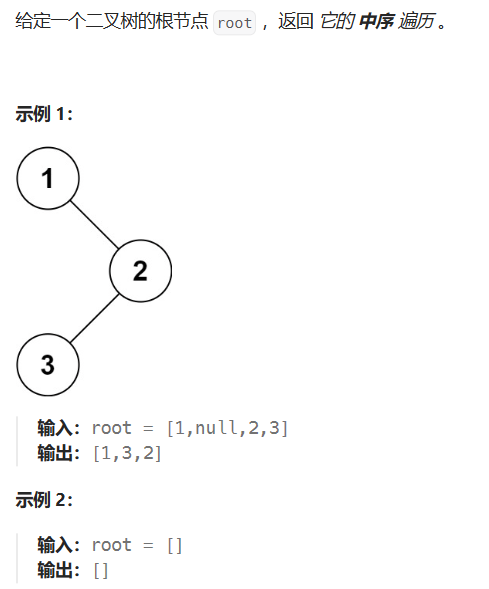
1
2
3
4
5
6
7
8
9
10
11
12
13
14
15
16
| class Solution {
public:
void Recursion(TreeNode* root,vector<int>& ans)
{
if(root == nullptr)
return;
Recursion(root->left,ans);
ans.push_back(root->val);
Recursion(root->right,ans);
}
vector<int> inorderTraversal(TreeNode* root) {
vector<int> ans;
Recursion(root,ans);
return ans;
}
};
|
迭代法
1
2
3
4
5
6
7
8
9
10
11
12
13
14
15
16
17
18
19
20
21
| class Solution {
public:
vector<int> inorderTraversal(TreeNode* root) {
stack<TreeNode*> st;
vector<int> ans;
TreeNode* cur = root;
while(cur || !st.empty())
{
while(cur)
{
st.push(cur);
cur = cur->left;
}
TreeNode* tmp = st.top();
ans.push_back(tmp->val);
st.pop();
cur = tmp->right;
}
}
};
|
1.3 145-二叉树的后序遍历
145
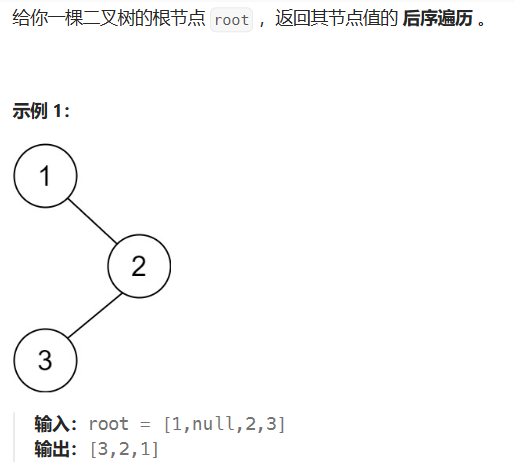
1
2
3
4
5
6
7
8
9
10
11
12
13
14
15
16
17
18
| class Solution
{
public:
void Recursion(TreeNode*& root,vector<int>& ans)
{
if(root==nullptr)
return;
Recursion(root->left,ans);
Recursion(root->right,ans);
ans.push_back(root->val);
}
vector<int> postorderTraversal(TreeNode* root)
{
vector<int> ans;
Recursion(root,ans);
return ans;
}
};
|
迭代法
1
2
3
4
5
6
7
8
9
10
11
12
13
14
15
16
17
18
19
20
21
22
23
24
25
26
27
| class Solution {
public:
vector<int> postorderTraversal(TreeNode* root) {
vector<int> ans;
stack<TreeNode*> st;
TreeNode* cur = root;
TreeNode* prev = nullptr;
while(cur || !st.empty())
{
while(cur)
{
st.push(cur);
cur=cur->left;
}
TreeNode* top = s.top();
if(!top->right || top->right == prev)
{
ans.push_back(top->val);
prev = top;
st.pop();
}
else
cur = top->right;
}
return ans;
}
};
|
1.4 102-二叉树的层序遍历
102
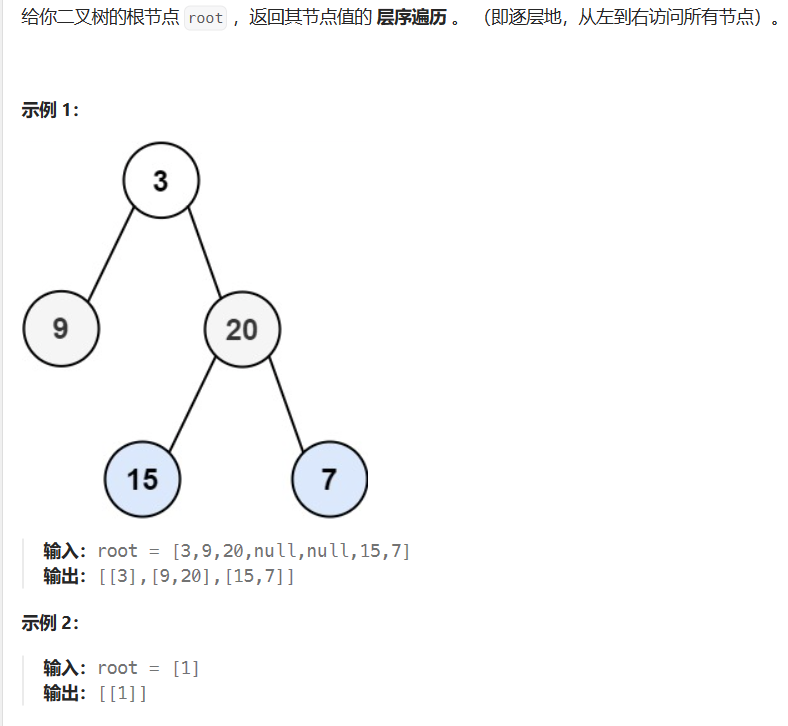
1
2
3
4
5
6
7
8
9
10
11
12
13
14
15
16
17
18
| class Solution {
public:
void Recursion(vector<vector<int>>& ans,TreeNode* root,int level)
{
if(!root)
return;
if(ans.size() <= level)
ans.push_back(vector<int>());
ans[level].push_back(root->val);
Recursion(ans,root->left,level+1);
Recursion(ans,root->right,level+1);
}
vector<vector<int>> levelOrder(TreeNode* root) {
vector<vector<int>> ans;
Recursion(ans,root,0);
return ans;
}
};
|
1.5 107-二叉树的层序遍历II
107
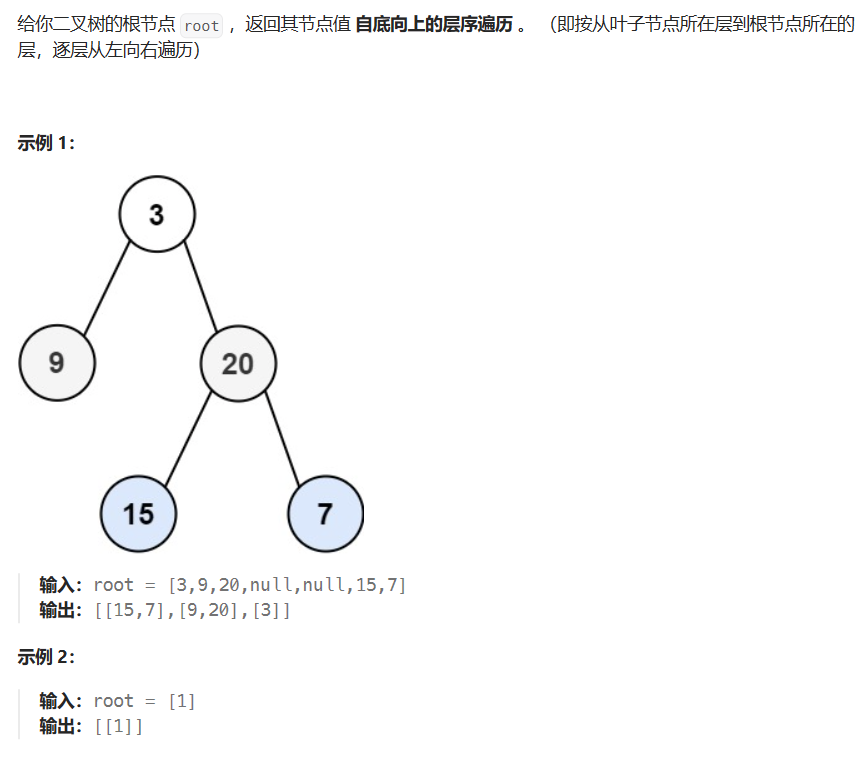
上一题reverse一下就可以了
1
2
3
4
5
6
7
8
9
10
11
12
13
14
15
16
17
18
19
| class Solution {
public:
void Recursion(vector<vector<int>>& ans,TreeNode* root,int level)
{
if(!root)
return;
if(ans.size() <= level)
ans.push_back(vector<int>());
ans[level].push_back(root->val);
Recursion(ans,root->left,level+1);
Recursion(ans,root->right,level+1);
}
vector<vector<int>> levelOrderBottom(TreeNode* root) {
vector<vector<int>> ans;
Recursion(ans,root,0);
reverse(ans.begin(),ans.end());
return ans;
}
};
|
也引入一下这题(上一题)的非递归写法
1
2
3
4
5
6
7
8
9
10
11
12
13
14
15
16
17
18
19
20
21
22
23
24
25
26
27
28
| class Solution {
public:
vector<vector<int>> levelOrderBottom(TreeNode* root) {
queue<TreeNode*> que;
if (root != NULL)
que.push(root);
vector<vector<int>> result;
while (!que.empty())
{
int size = que.size();
vector<int> vec;
for (int i = 0; i < size; i++)
{
TreeNode* node = que.front();
que.pop();
vec.push_back(node->val);
if (node->left)
que.push(node->left);
if (node->right)
que.push(node->right);
}
result.push_back(vec);
}
reverse(result.begin(), result.end());
return result;
}
};
|
1.6 199-二叉树的右视图
199
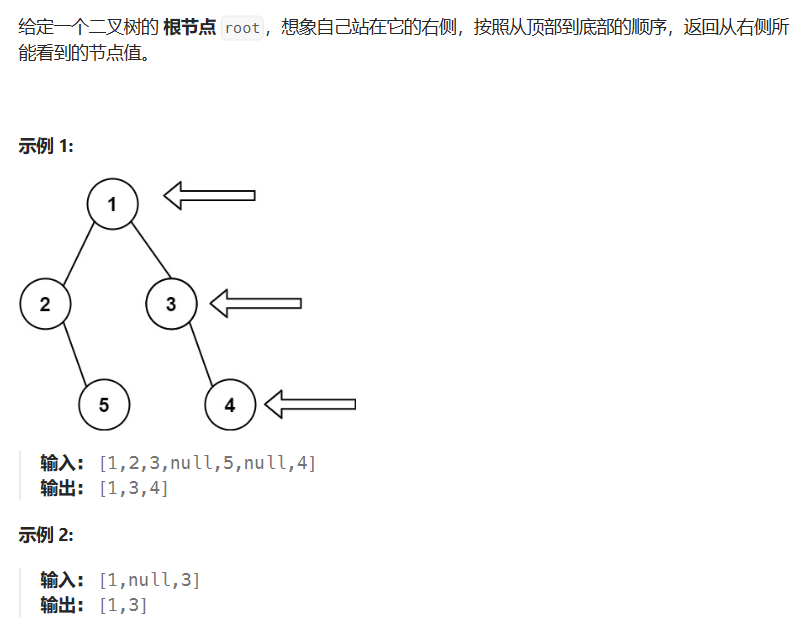
1
2
3
4
5
6
7
8
9
10
11
12
13
14
15
16
17
18
19
20
21
22
23
24
25
| class Solution {
public:
vector<int> rightSideView(TreeNode* root) {
queue<TreeNode*> que;
vector<int> ans;
if(root)
que.push(root);
while(!que.empty())
{
int size = que.size();
for(int i = 0; i < size;i++)
{
TreeNode* tmp = que.front();
que.pop();
if(i == (size-1))
ans.push_back(tmp->val);
if(tmp->left)
que.push(tmp->left);
if(tmp->right)
que.push(tmp->right);
}
}
return ans;
}
};
|
1.7* 637-二叉树的层平均值
637
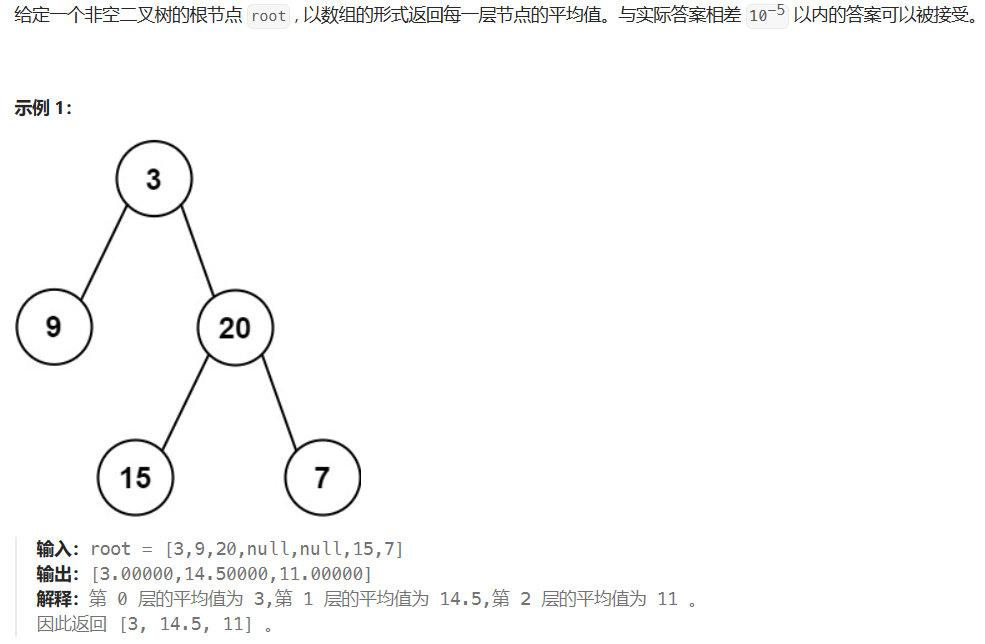
1
2
3
4
5
6
7
8
9
10
11
12
13
14
15
16
17
18
19
20
21
22
23
24
25
26
27
| class Solution {
public:
vector<double> averageOfLevels(TreeNode* root) {
queue<TreeNode*> que;
vector<double> ans;
if(root)
que.push(root);
while(!que.empty())
{
int size = que.size();
double sum = 0;
for(int i = 0; i < size; ++i)
{
TreeNode* tmp = que.front();
que.pop();
sum+=tmp->val;
if(tmp->left)
que.push(tmp->left);
if(tmp->right)
que.push(tmp->right);
}
ans.push_back(sum/size);
}
return ans;
}
};
|
1.8* 429-N叉树的层序遍历
429
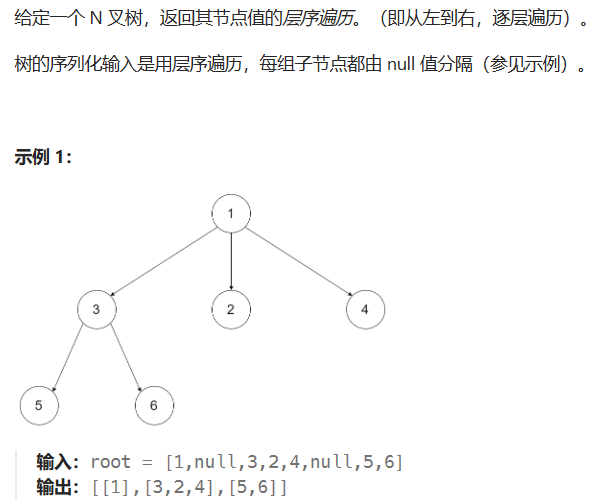
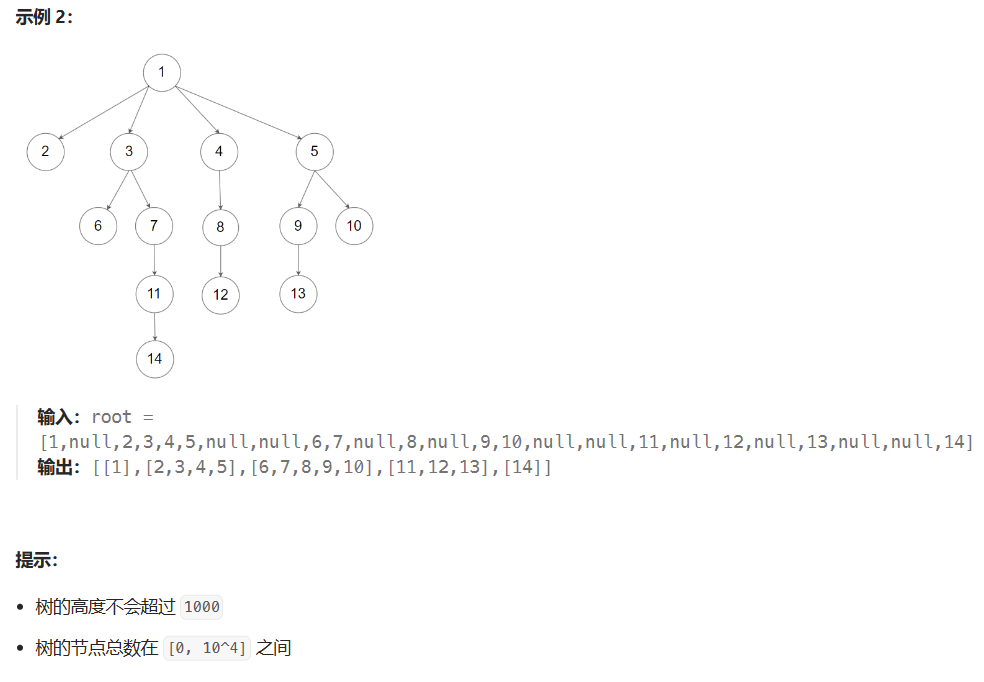
1
2
3
4
5
6
7
8
9
10
11
12
13
14
15
16
17
18
19
20
21
22
23
24
25
26
27
28
29
30
31
32
33
34
35
36
37
38
39
40
41
42
43
44
45
46
|
class Solution {
public:
vector<vector<int>> levelOrder(Node* root) {
queue<Node*> que;
vector<vector<int>> ans;
if(root)
que.push(root);
while(!que.empty())
{
int size = que.size();
vector<int> tmp_v;
for(int i = 0; i < size; ++i)
{
Node* node = que.front();
que.pop();
tmp_v.push_back(node->val);
for(int j = 0; j < node->children.size(); ++j)
if(node->children[j])
que.push(node->children[j]);
}
ans.push_back(tmp_v);
}
return ans;
}
};
|
1.9 515-在每个树行中找最大值
515
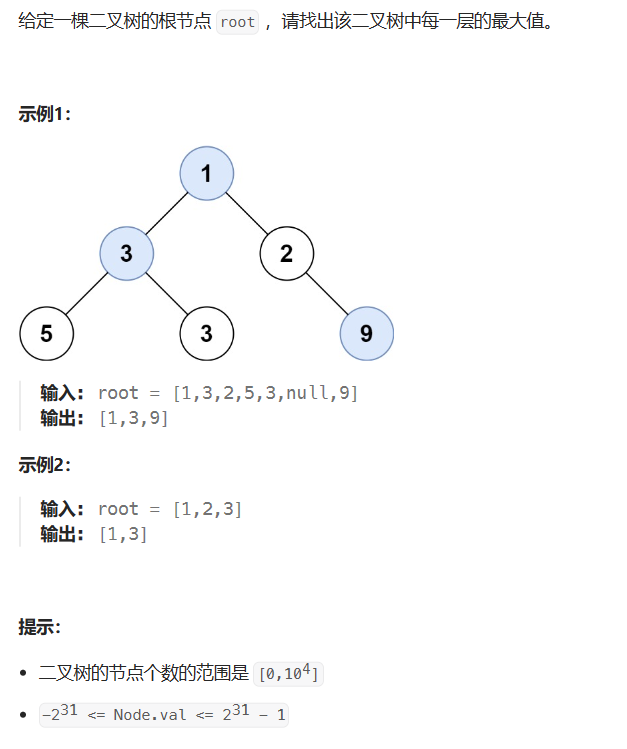
1
2
3
4
5
6
7
8
9
10
11
12
13
14
15
16
17
18
19
20
21
22
23
24
25
26
27
| class Solution {
public:
vector<int> largestValues(TreeNode* root) {
vector<int> ans;
queue<TreeNode*> que;
if(root)
que.push(root);
while(!que.empty())
{
int size = que.size();
int max = INT_MIN;
for(int i = 0; i < size;++i)
{
TreeNode* tmp = que.front();
que.pop();
if(tmp->val>max)
max = tmp->val;
if(tmp->left)
que.push(tmp->left);
if(tmp->right)
que.push(tmp->right);
}
ans.push_back(max);
}
return ans;
}
};
|
1.10* 116-填充每个节点的下一个右侧节点指针
116
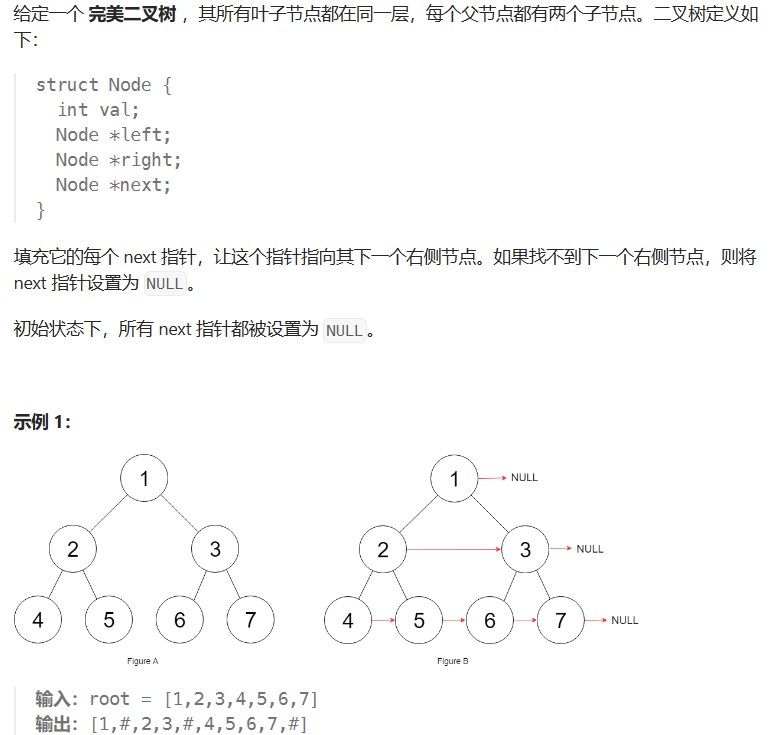

1
2
3
4
5
6
7
8
9
10
11
12
13
14
15
16
17
18
19
20
21
22
23
24
25
26
27
28
29
30
31
32
33
34
35
36
37
38
39
|
class Solution {
public:
Node* connect(Node* root) {
if(!root)
return nullptr;
Node* leftest = root;
while(leftest->left)
{
Node* cur = leftest;
while(cur)
{
cur->left->next = cur->right;
if(cur->next)
cur->right->next = cur->next->left;
cur = cur->next;
}
leftest = leftest->left;
}
return root;
}
};
|
若使用普通的层序遍历那么空间复杂度会达到N
而这种方式空间复杂度为1
1.11 117-填充每个节点的下一个右侧节点指针II
117
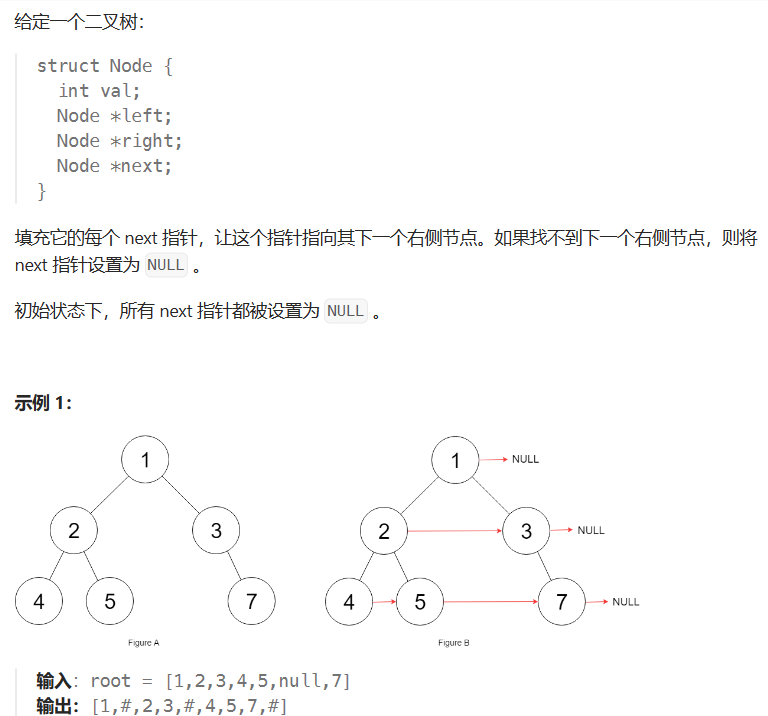

上一题是完全二叉树
1
2
3
4
5
6
7
8
9
10
11
12
13
14
15
16
17
18
19
20
21
22
23
24
25
26
27
28
29
30
31
32
33
34
35
36
37
38
39
|
class Solution {
public:
Node* connect(Node* root) {
if(root && (root->left || root->right))
{
if(root->left && root->right)
root->left->next = root->right;
Node* child = root->right ? root->right : root->left;
Node* brodady = root->next;
while(brodady && !(brodady->left||brodady->right))
brodady = brodady->next;
child->next = brodady ? (brodady->left ? brodady->left : brodady->right) : nullptr;
connect(root->right);
connect(root->left);
}
return root;
}
};
|
1.12 104-二叉树的最大深度
104
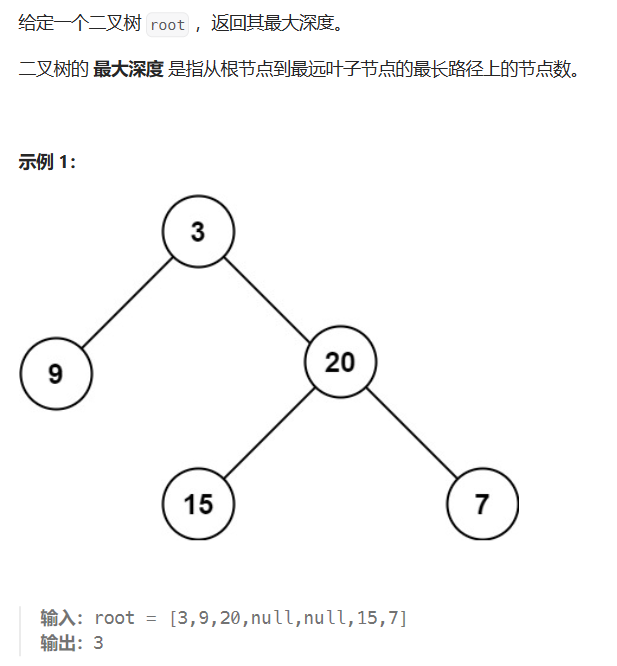
1
2
3
4
5
6
7
8
| class Solution {
public:
int maxDepth(TreeNode* root) {
if(!root)
return 0;
return max(maxDepth(root->left), maxDepth(root->right)) + 1;
}
};
|
1.13 111-二叉树的最小深度
111
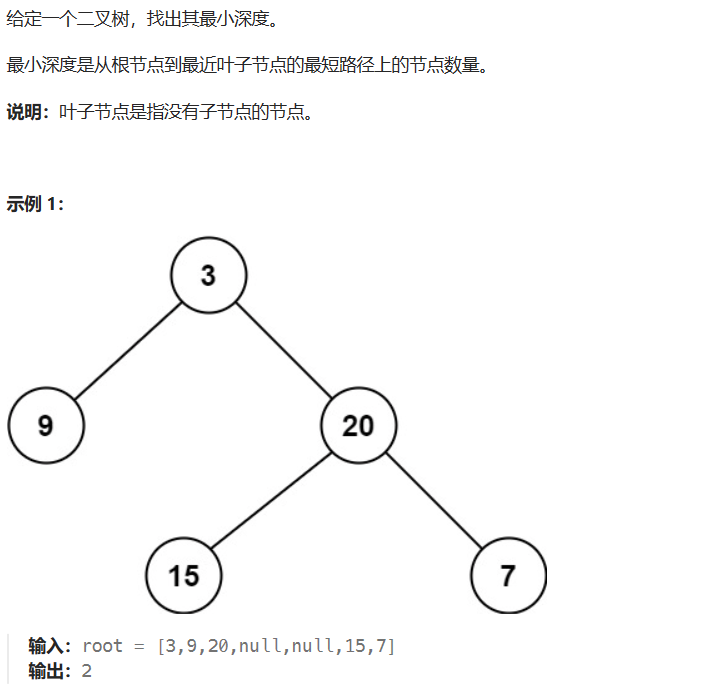
1
2
3
4
5
6
7
8
9
10
11
12
13
14
15
16
| class Solution {
public:
int minDepth(TreeNode* root) {
if(!root)
return 0;
if(!root->left && !root->right)
return 1;
int min_depth = INT_MAX;
if(root->left)
min_depth = min(minDepth(root->left),min_depth);
if(root->right)
min_depth = min(minDepth(root->right),min_depth);
return min_depth+1;
}
};
|
2. 二叉树之常见算法
2.1 226-翻转二叉树
226
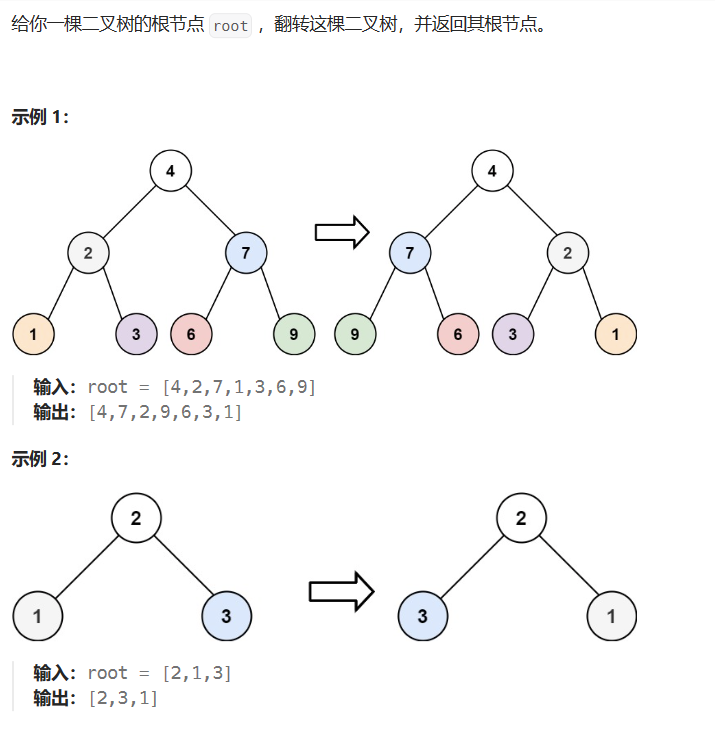
1
2
3
4
5
6
7
8
9
10
11
| class Solution {
public:
TreeNode* invertTree(TreeNode* root) {
if(!root)
return nullptr;
swap(root->left,root->right);
invertTree(root->left);
invertTree(root->right);
return root;
}
};
|
2.2 101-对称二叉树
101
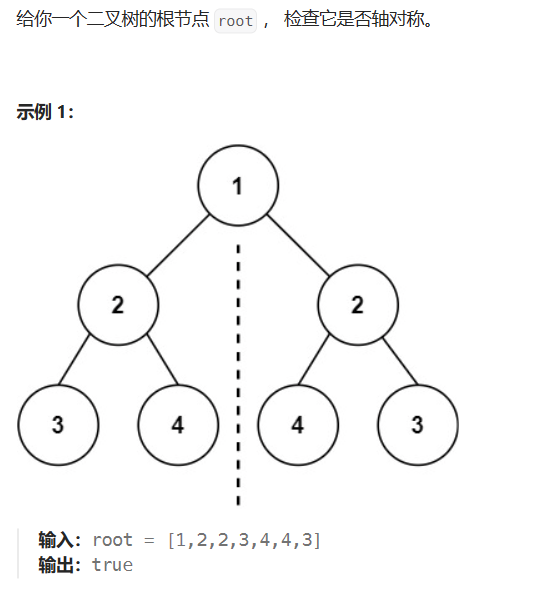
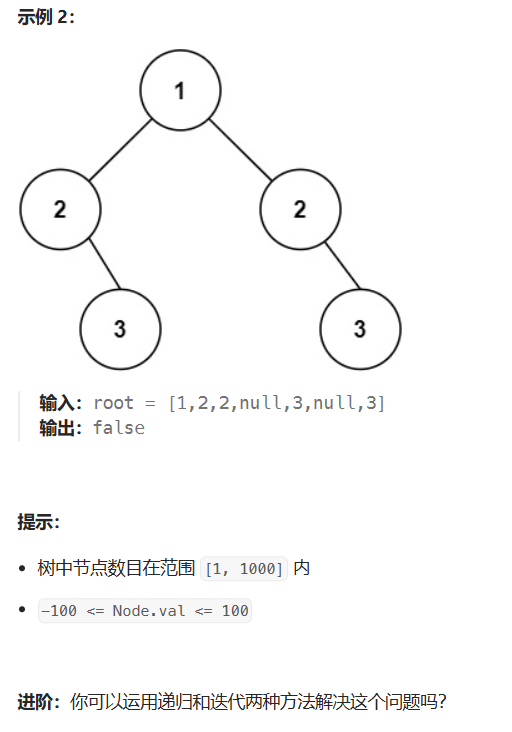
递归
1
2
3
4
5
6
7
8
9
10
11
12
13
14
15
16
17
18
| class Solution {
public:
bool Recursion(TreeNode* left,TreeNode* right)
{
if(!left&&right || left&&!right)
return false;
if(!left && !right)
return true;
if(left->val != right->val)
return false;
return Recursion(left->left,right->right) &&
Recursion(left->right,right->left);
}
bool isSymmetric(TreeNode* root) {
return Recursion(root->left,root->right);
}
};
|
迭代(栈)
1
2
3
4
5
6
7
8
9
10
11
12
13
14
15
16
17
18
19
20
21
22
23
24
25
26
27
| class Solution {
public:
bool isSymmetric(TreeNode* root) {
stack<TreeNode*> st;
st.push(root->left);
st.push(root->right);
while (!st.empty())
{
TreeNode* leftNode = st.top();
st.pop();
TreeNode* rightNode = st.top();
st.pop();
if (!leftNode && !rightNode)
continue;
if ((!leftNode || !rightNode || (leftNode->val != rightNode->val)))
return false;
st.push(leftNode->left);
st.push(rightNode->right);
st.push(leftNode->right);
st.push(rightNode->left);
}
return true;
}
};
|
2.3* 222-完全二叉树的节点个数
222
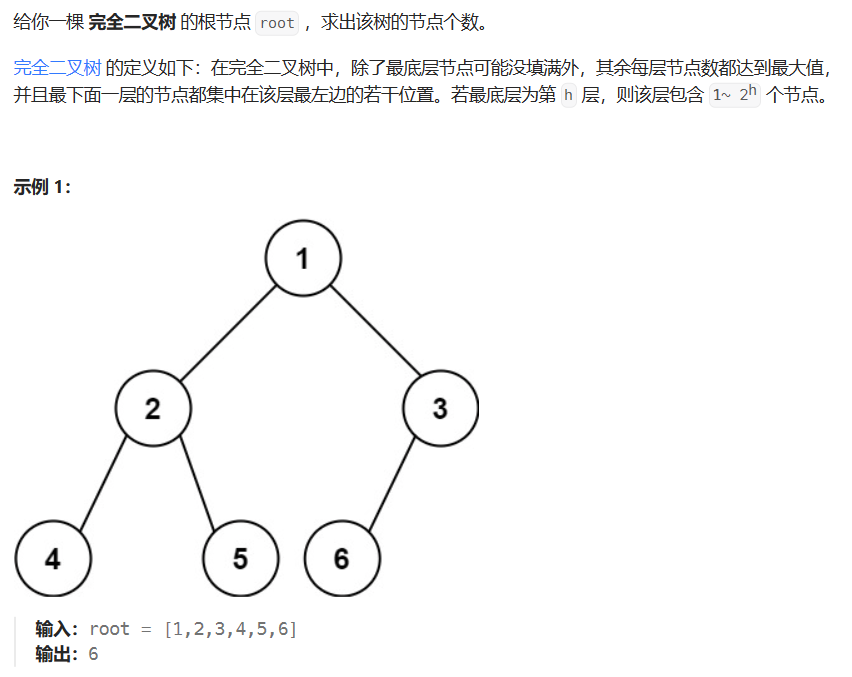
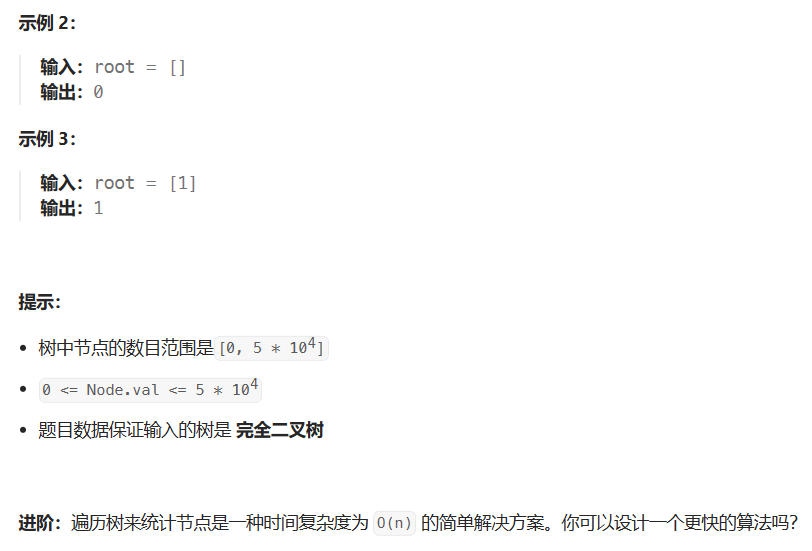
递归遍历 O(N)
1
2
3
4
5
6
7
8
9
10
11
12
13
14
15
16
| class Solution {
public:
void Recursion(TreeNode* root,int& count)
{
if(!root)
return;
count++;
Recursion(root->left,count);
Recursion(root->right,count);
}
int countNodes(TreeNode* root) {
int count = 0;
Recursion(root,count);
return count;
}
};
|
精简版递归
1
2
3
4
5
6
7
8
9
| class Solution {
public:
int countNodes(TreeNode* root) {
if (root == NULL)
return 0;
return 1 + countNodes(root->left)
+ countNodes(root->right);
}
};
|
最优
1
2
3
4
5
6
7
8
9
10
11
12
13
14
15
16
17
18
19
20
21
22
23
24
25
26
27
28
29
30
31
32
33
34
35
36
37
38
39
40
41
| class Solution {
public:
int countNodes(TreeNode* root)
{
if (!root)
return 0;
int level = 0;
TreeNode* cur = root;
while (cur->left)
{
level++;
cur = cur->left;
}
int low = 1 << level;
int high = (1 << (level + 1)) - 1;
while (low < high)
{
int mid = (high - low + 1) / 2 + low;
if (exists(root, level, mid))
low = mid;
else
high = mid - 1;
}
return low;
}
bool exists(TreeNode* root, int level, int mid)
{
int bits = 1 << (level - 1);
TreeNode* cur = root;
while (cur && bits > 0)
{
if (bits & mid)
cur = cur->right;
else
cur = cur->left;
bits >>= 1;
}
return cur != nullptr;
}
};
|
时间复杂度:O(logN*logN)
空间复杂度:O(1)
2.4 110-平衡二叉树
110
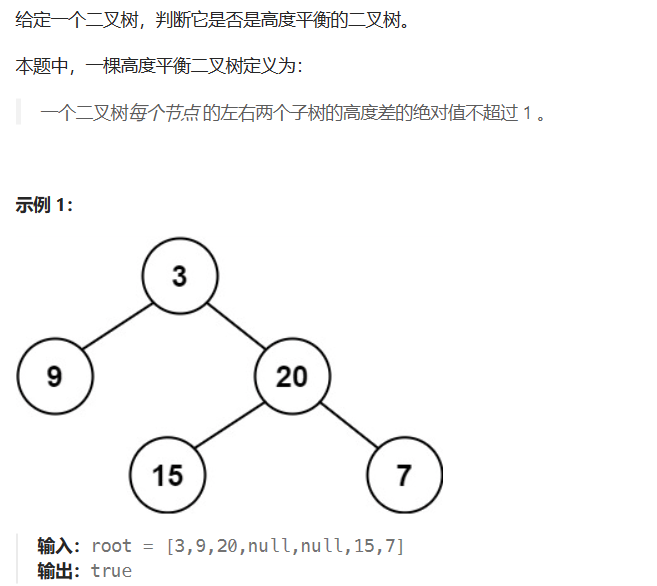
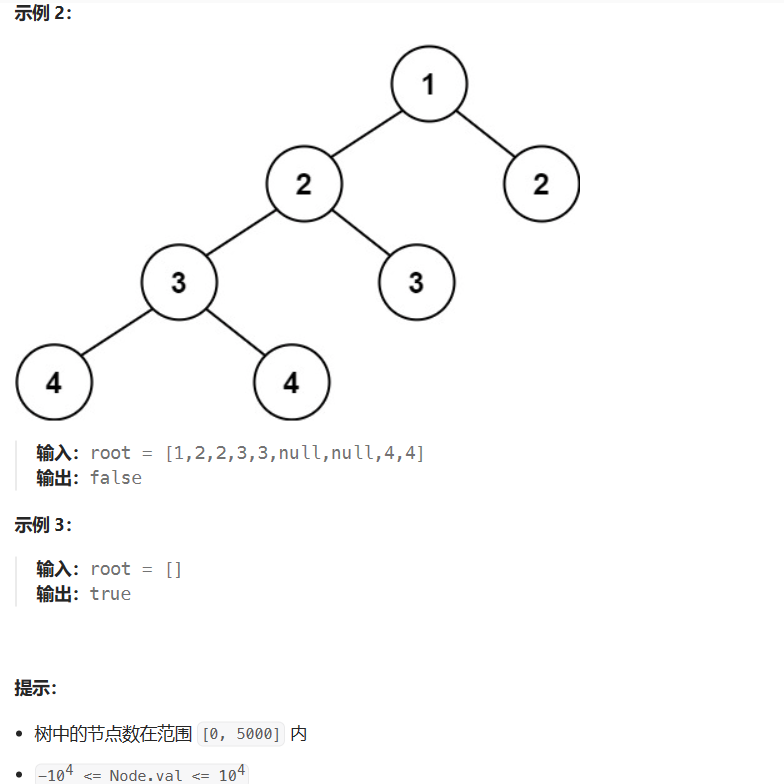
1
2
3
4
5
6
7
8
9
10
11
12
13
14
15
16
17
18
19
20
21
22
23
| class Solution {
public:
int Recursion(TreeNode* root)
{
if(!root)
return 0;
int left = Recursion(root->left);
if(left == -1)
return -1;
int right = Recursion(root->right);
if(right == -1)
return -1;
if(abs(left-right) > 1)
return -1;
return left>right?left+1:right+1;
}
bool isBalanced(TreeNode* root)
{
if(Recursion(root) == -1)
return false;
return true;
}
};
|
2.5 257-二叉树的所有路径
257
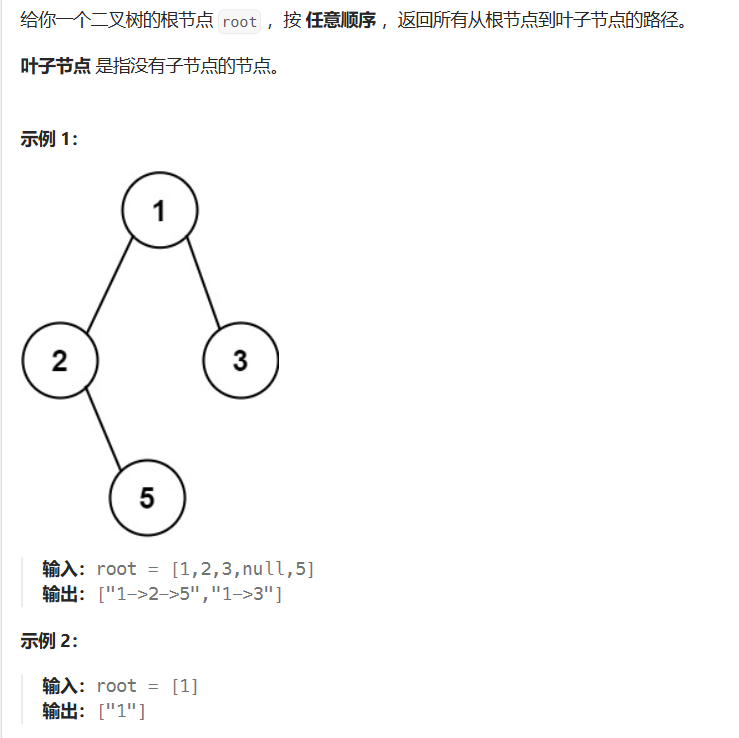

1
2
3
4
5
6
7
8
9
10
11
12
13
14
15
16
17
18
19
20
21
22
23
| class Solution {
public:
void Recursion(TreeNode* root,vector<string>& vs,string s)
{
if(root&&!root->left&&!root->right)
{
s+=(to_string(root->val));
vs.push_back(s);
return;
}
if(!root)
return;
s+=(to_string(root->val)+"->");
Recursion(root->left,vs,s);
Recursion(root->right,vs,s);
}
vector<string> binaryTreePaths(TreeNode* root) {
vector<string> vs;
string s;
Recursion(root,vs,s);
return vs;
}
};
|
2.6 404-左子叶之和
404
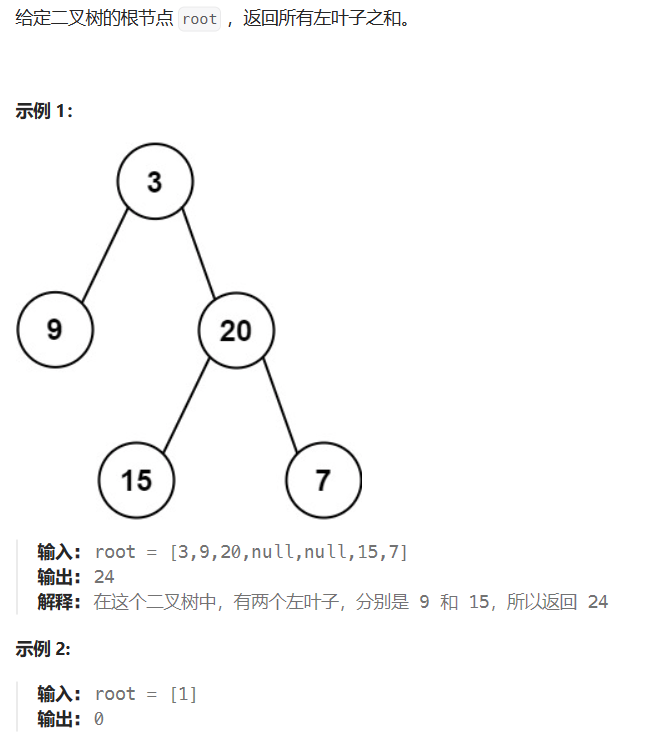
1
2
3
4
5
6
7
8
9
10
11
12
| class Solution {
public:
int sumOfLeftLeaves(TreeNode* root) {
if (!root)
return 0;
int leftValue = 0;
if (root->left && !root->left->left && !root->left->right)
leftValue = root->left->val;
return leftValue + sumOfLeftLeaves(root->left) + sumOfLeftLeaves(root->right);
}
};
|
2.7* 513-找树左下角的值
513
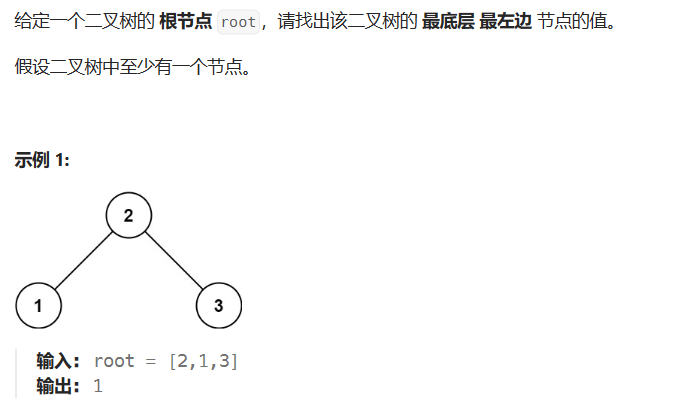
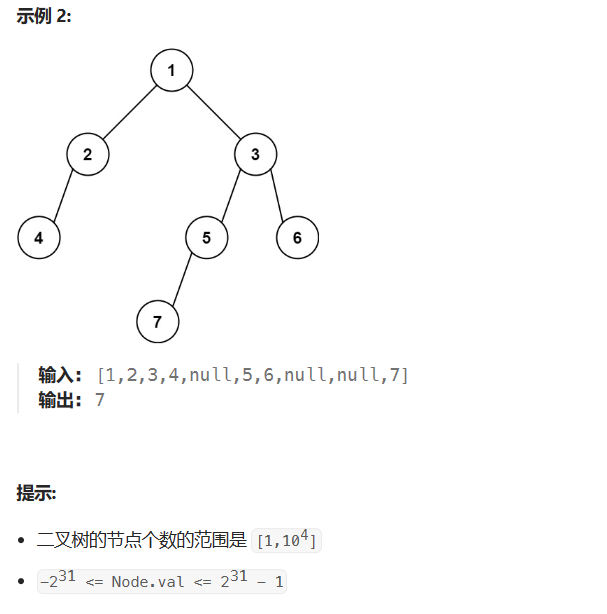
dfs
1
2
3
4
5
6
7
8
9
10
11
12
13
14
15
16
17
18
19
20
21
22
23
24
25
| class Solution {
public:
void Recursion(TreeNode* cur,int curdep,int& maxdep,int& ans)
{
if(!cur->left&&!cur->right)
{
if(curdep>maxdep)
{
maxdep = dep;
ans = cur->val;
}
return;
}
if(cur->left)
Recursion(cur->left,dep+1,maxdep,ans);
if(cur->right)
Recursion(cur->right,dep+1,maxdep,ans);
}
int findBottomLeftValue(TreeNode* root) {
int ans = root->val;
int maxdep = 0;
Recursion(root,0,maxdep,ans);
return ans;
}
};
|
bfs
1
2
3
4
5
6
7
8
9
10
11
12
13
14
15
16
17
18
19
| class Solution {
public:
int findBottomLeftValue(TreeNode* root) {
int ans = 0;
queue<TreeNode*> que;
que.push(root);
while(!que.empty())
{
TreeNode* cur = que.front();
que.pop();
if(cur->right)
que.push(cur->right);
if(cur->left)
que.push(cur->left);
ans = cur->val;
}
return ans;
}
};
|
2.8 112-路径总和
112
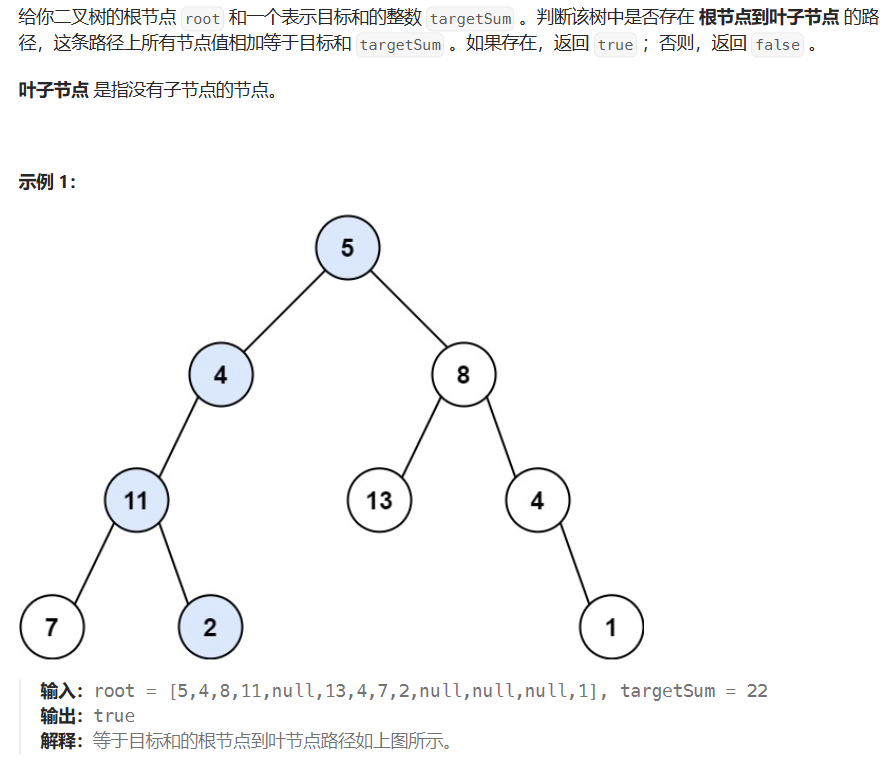
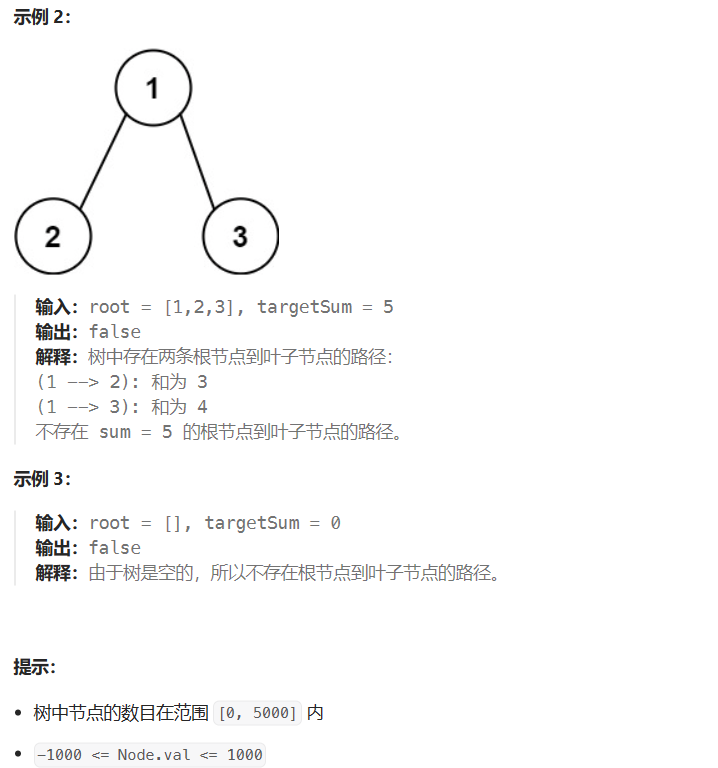
1
2
3
4
5
6
7
8
9
10
11
12
13
14
15
16
| class Solution {
public:
bool Recursion(TreeNode* cur,int sum,int target)
{
if(!cur)
return false;
if(!cur->left&&!cur->right&&sum+cur->val == target)
return true;
return Recursion(cur->left,sum+cur->val,target)
||Recursion(cur->right,sum+cur->val,target);
}
bool hasPathSum(TreeNode* root, int targetSum) {
return Recursion(root,0,targetSum);
}
};
|
2.9* 106-从中序与后续遍历序列构造二叉树
106
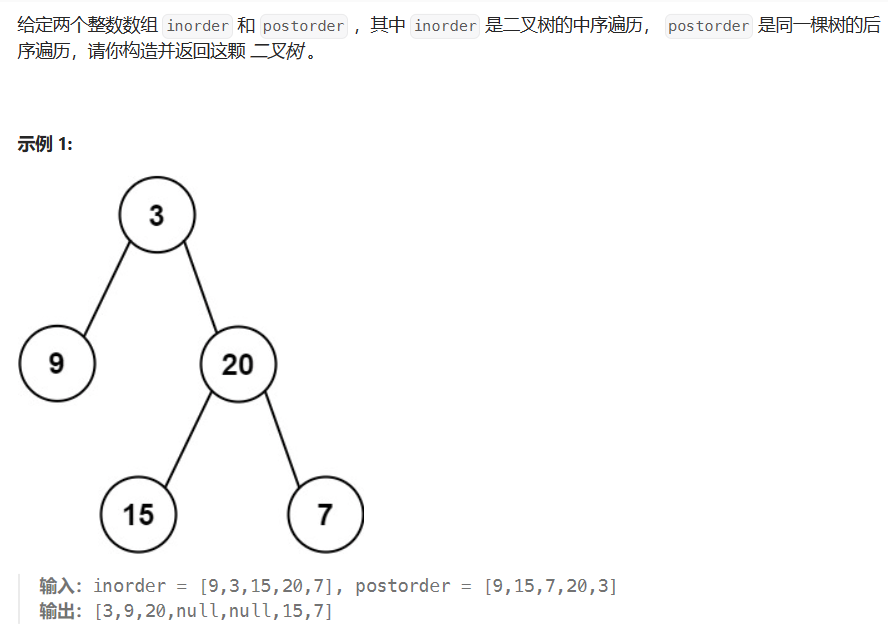
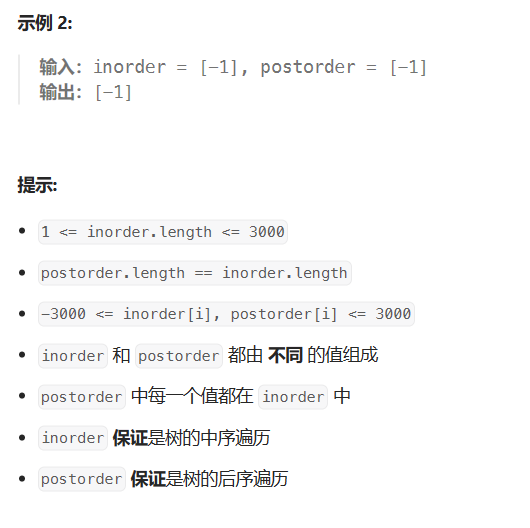
1
2
3
4
5
6
7
8
9
10
11
12
13
14
15
16
17
18
19
20
21
22
23
| class Solution {
public:
TreeNode* Recursion(vector<int>& inorder,vector<int>& postorder,int& rootindex,int left,int right)
{
if(left > right)
return nullptr;
TreeNode* cur = new TreeNode(postorder[rootindex]);
int mid = 0;
for(mid = inorder.size()-1 ; mid >=0 ; --mid)
if(inorder[mid] == postorder[rootindex])
break;
rootindex--;
cur->right = Recursion(inorder,postorder,rootindex,mid+1,right);
cur->left = Recursion(inorder,postorder,rootindex,left,mid-1);
return cur;
}
TreeNode* buildTree(vector<int>& inorder, vector<int>& postorder) {
int rootindex = postorder.size() - 1;
return Recursion(inorder,postorder,rootindex,0,rootindex);
}
};
|
2.10* 105-从前序与中序遍历序列构造二叉树
105
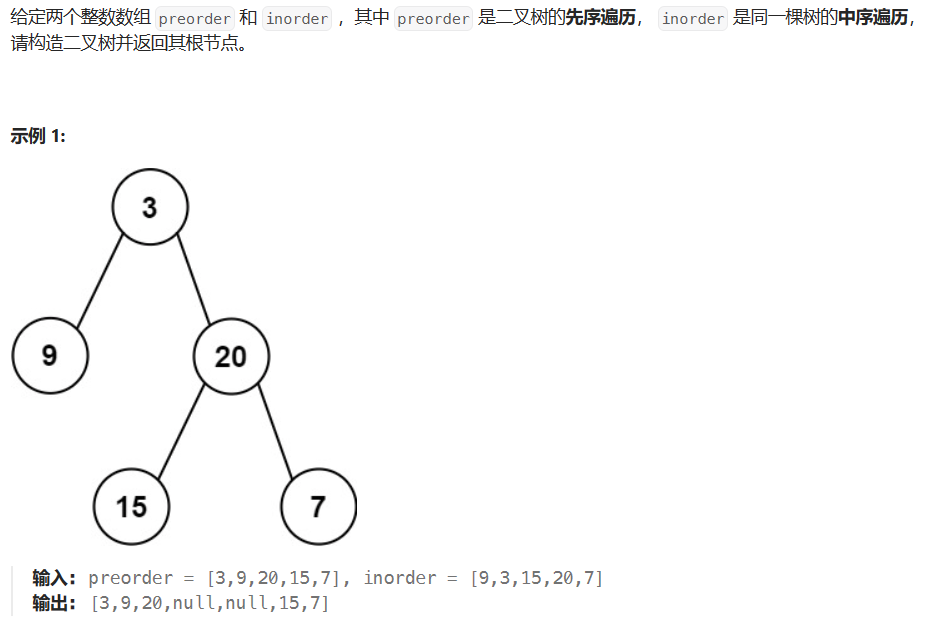
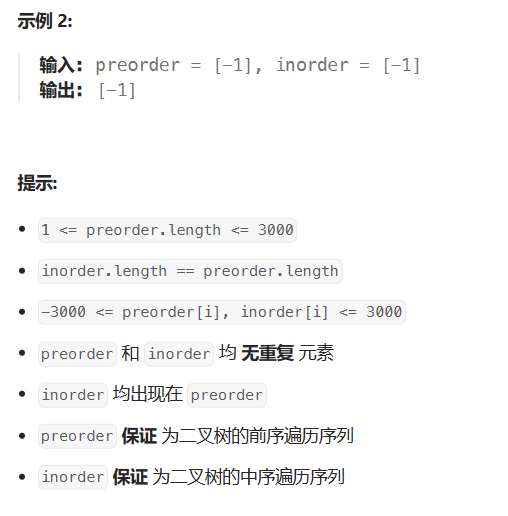
1
2
3
4
5
6
7
8
9
10
11
12
13
14
15
16
17
18
19
20
21
| class Solution {
public:
TreeNode* Recursion(vector<int>& preorder, vector<int>& inorder,int& rootindex,int left , int right)
{
if(left > right)
return nullptr;
TreeNode* cur = new TreeNode(preorder[rootindex]);
int mid = 0;
for(mid = 0 ; mid < inorder.size() ; ++mid)
if(inorder[mid] == preorder[rootindex])
break;
rootindex++;
cur->left = Recursion(preorder,inorder,rootindex,left,mid-1);
cur->right = Recursion(preorder,inorder,rootindex,mid+1,right);
return cur;
}
TreeNode* buildTree(vector<int>& preorder, vector<int>& inorder) {
int rootindex = 0;
return Recursion(preorder,inorder,rootindex,0,preorder.size()-1);
}
};
|
2.11* 654-最大二叉树
654

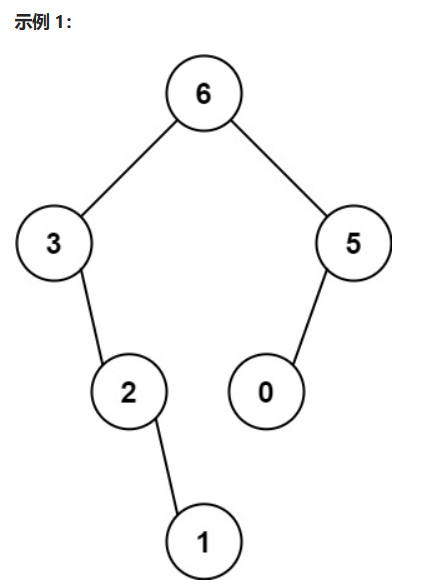
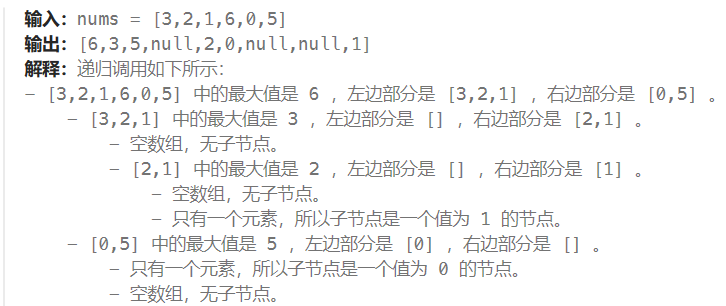

1
2
3
4
5
6
7
8
9
10
11
12
13
14
15
16
17
18
19
20
21
22
23
24
25
| class Solution {
public:
TreeNode* Recursion(vector<int>& nums,int left,int right)
{
if(left > right)
return nullptr;
int mid = left;
int max = 0;
for(int i = mid ; i <= right ; ++i)
{
if(nums[i] > max)
{
mid = i;
max = nums[i];
}
}
TreeNode* cur = new TreeNode(max);
cur->left = Recursion(nums,left,mid-1);
cur->right = Recursion(nums,mid+1,right);
return cur;
}
TreeNode* constructMaximumBinaryTree(vector<int>& nums) {
return Recursion(nums,0,nums.size()-1);
}
};
|
2.12 617-合并二叉树
617
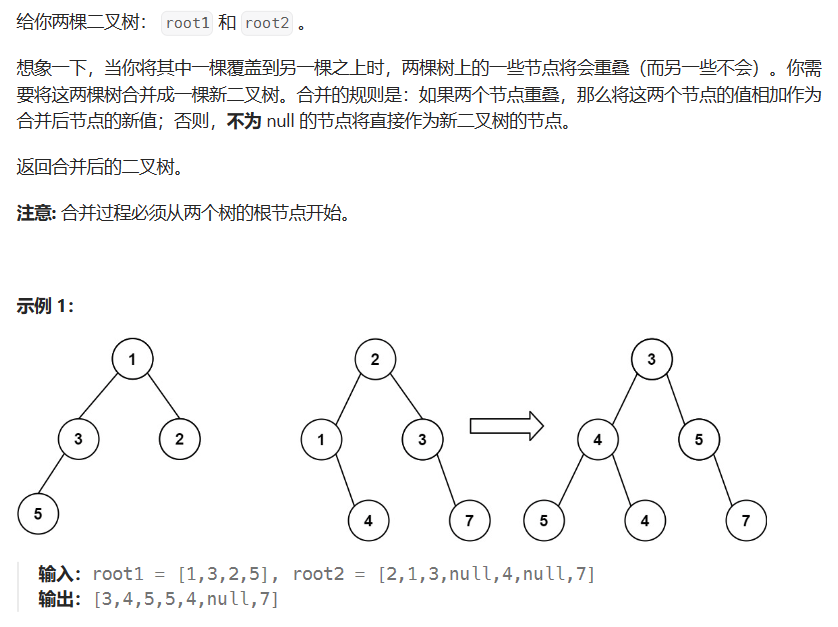
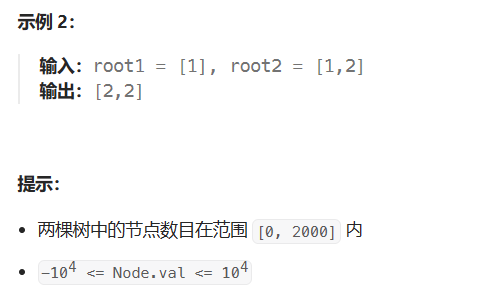
1
2
3
4
5
6
7
8
9
10
11
12
13
| class Solution {
public:
TreeNode* mergeTrees(TreeNode* root1, TreeNode* root2) {
if(!root1)
return root2;
if(!root2)
return root1;
TreeNode* root = new TreeNode(root1->val+root2->val);
root->left = mergeTrees(root1->left,root2->left);
root->right = mergeTrees(root1->right,root2->right);
return root;
}
};
|
2.13* 236-二叉树的最近公共祖先
236
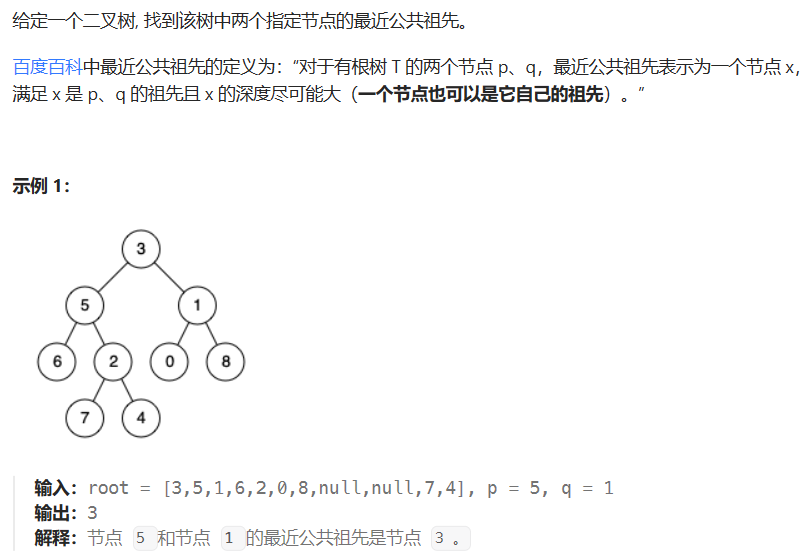
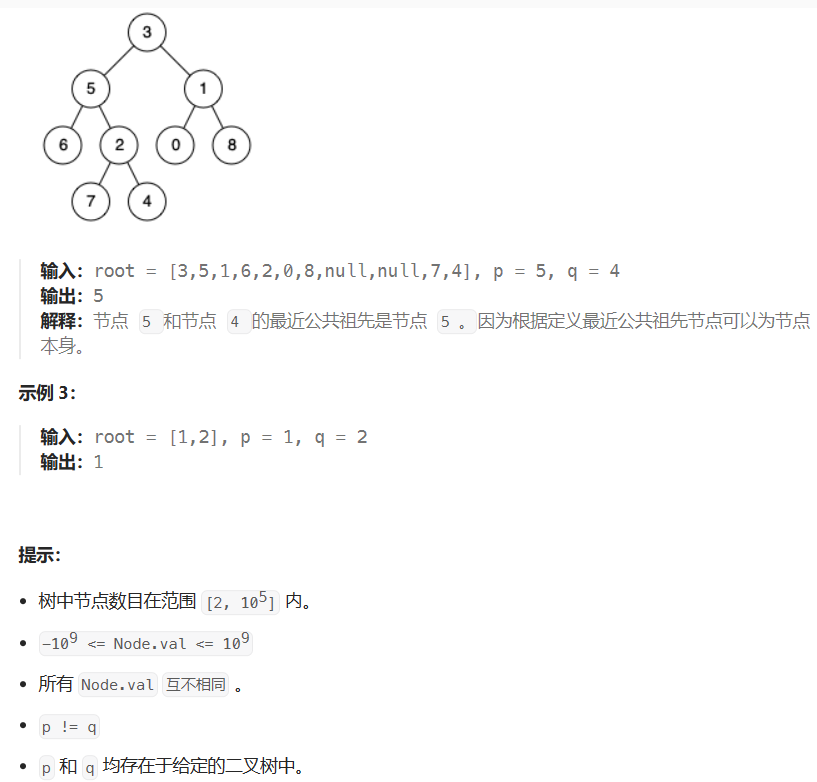
1
2
3
4
5
6
7
8
9
10
11
12
13
14
15
16
17
18
19
20
21
22
23
24
25
26
27
28
29
30
|
class Solution {
public:
TreeNode* lowestCommonAncestor(TreeNode* root, TreeNode* p, TreeNode* q) {
if(!root)
return nullptr;
if(root == p || root == q)
return root;
TreeNode* left = lowestCommonAncestor(root->left,p,q);
TreeNode* right = lowestCommonAncestor(root->right,p,q);
if(left&&right)
return root;
else if(!left&&right)
return right;
else if(left&&!right)
return left;
else
return nullptr;
}
};
|
3. 二叉搜索树
3.1 700-二叉搜索树中的搜索
700
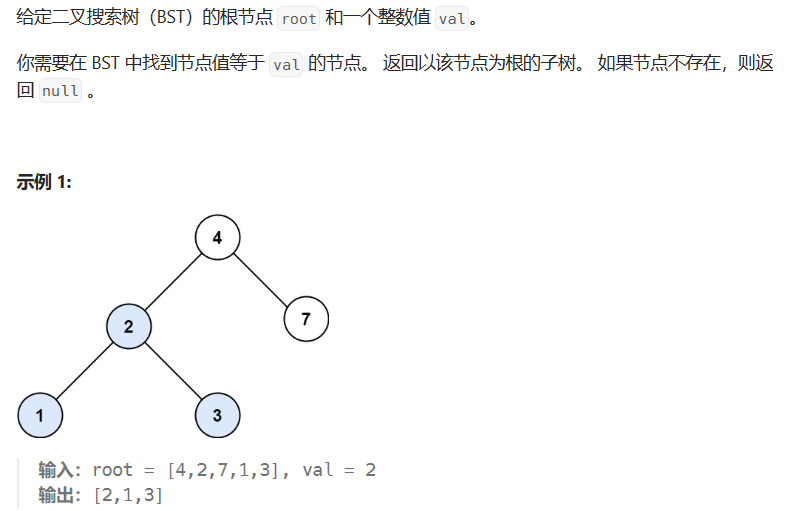
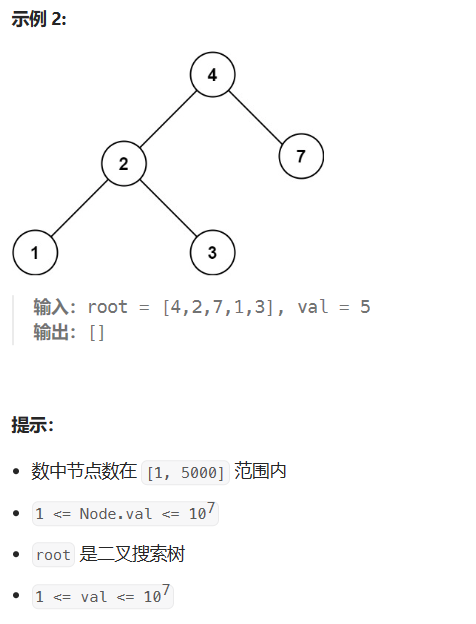
1
2
3
4
5
6
7
8
9
10
11
12
13
| class Solution {
public:
TreeNode* searchBST(TreeNode* root, int val) {
if(!root)
return nullptr;
if(val < root->val)
return searchBST(root->left,val);
else if(val > root->val)
return searchBST(root->right,val);
else
return root;
}
};
|
3.2* 98-验证二叉搜索树
98
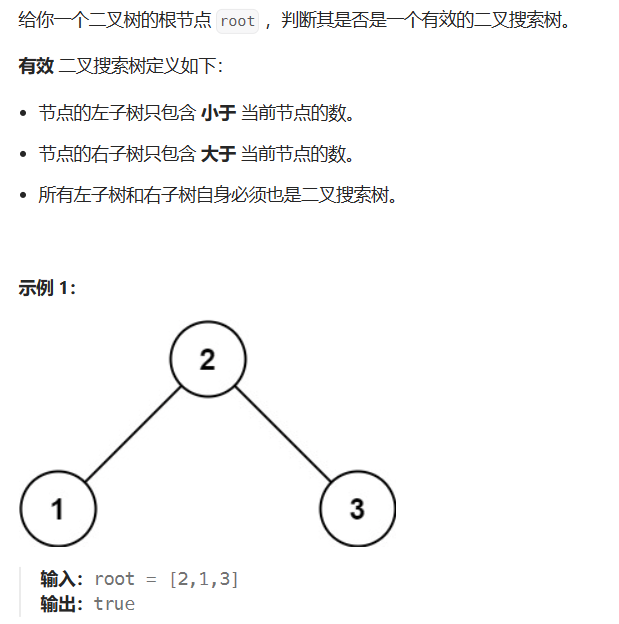
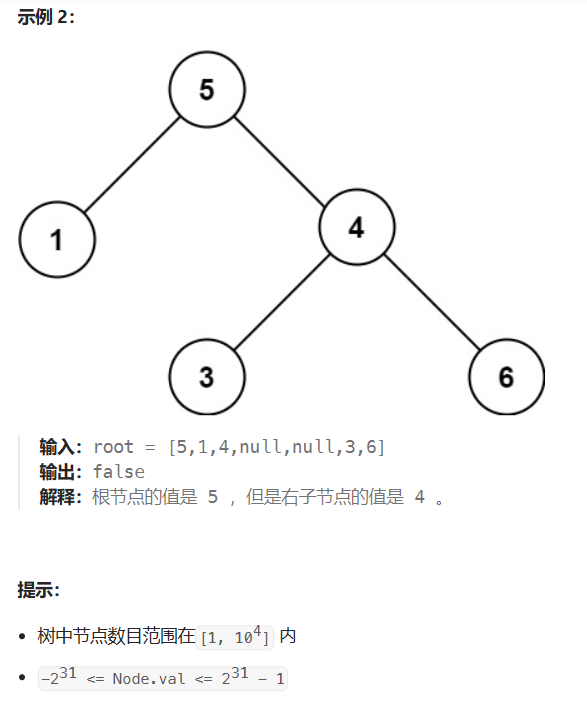
1
2
3
4
5
6
7
8
9
10
11
12
13
| class Solution {
public:
bool isValidBST(TreeNode* root,TreeNode* minNode = nullptr,TreeNode* maxNode = nullptr) {
if(!root)
return true;
if((minNode && root->val <= minNode->val) ||
(maxNode && root->val >= maxNode->val))
return false;
return isValidBST(root->left,minNode,root) &&
isValidBST(root->right,root,maxNode);
}
};
|
更直观的方法
1
2
3
4
5
6
7
8
9
10
11
12
13
14
15
16
17
18
19
20
21
22
23
24
25
26
27
28
29
30
31
32
33
| class Solution {
public:
bool isValidBST(TreeNode* root)
{
if(!root)
return true;
if(root->left)
{
TreeNode* tmp = root->left;
if(tmp->val>=root->val)
return false;
while(tmp->right)
{
tmp = tmp->right;
if(tmp->val>=root->val)
return false;
}
}
if(root->right)
{
TreeNode* tmp = root->right;
if(tmp->val<=root->val)
return false;
while(tmp->left)
{
tmp = tmp->left;
if(tmp->val<=root->val)
return false;
}
}
return isValidBST(root->left) && isValidBST(root->right);
}
};
|
3.3 530-二叉搜索树的最小绝对差
530
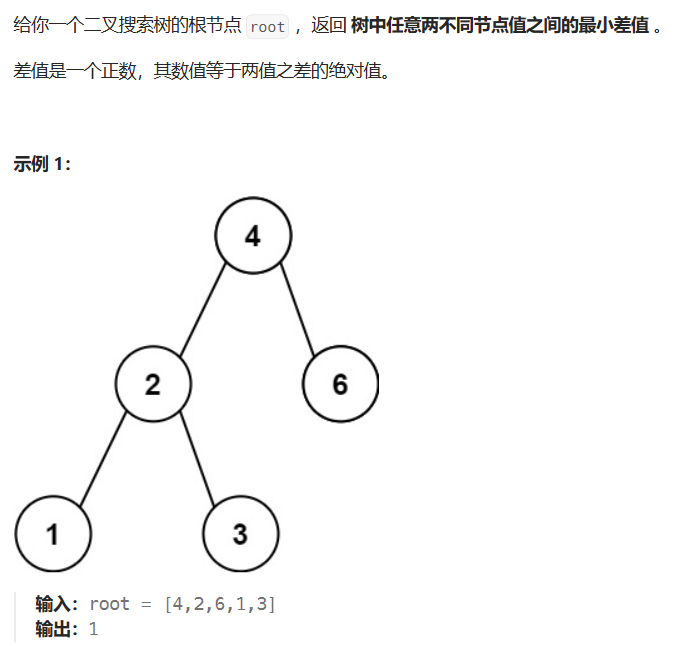
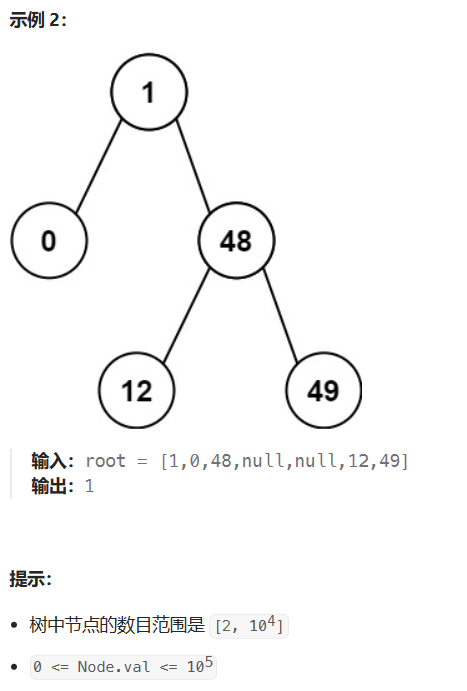
递归
1
2
3
4
5
6
7
8
9
10
11
12
13
14
15
16
17
18
19
20
21
| class Solution {
public:
void Recursion(TreeNode* root,TreeNode*& prev,int& mindif)
{
if(!root)
return;
Recursion(root->left,prev,mindif);
if(prev)
mindif = min(mindif,abs(root->val-prev->val));
prev = root;
Recursion(root->right,prev,mindif);
}
int getMinimumDifference(TreeNode* root)
{
int mindif = INT_MAX;
TreeNode* prev = nullptr;
Recursion(root,prev,mindif);
return mindif;
}
};
|
完全遍历
1
2
3
4
5
6
7
8
9
10
11
12
13
14
15
16
17
18
19
20
21
22
23
24
25
26
27
28
29
30
31
32
33
34
35
36
37
38
39
| class Solution {
public:
void Recursion(TreeNode* root,int& min)
{
if(!root)
return;
int tmp;
if(root->left)
{
TreeNode* left = root->left;
while(left)
{
tmp =abs(root->val-left->val);
if(tmp<min)
min = tmp;
left = left->right;
}
}
if(root->right)
{
TreeNode* right = root->right;
while(right)
{
tmp = abs(root->val-right->val);
if(tmp<min)
min = tmp;
right = right->left;
}
}
Recursion(root->left,min);
Recursion(root->right,min);
}
int getMinimumDifference(TreeNode* root)
{
int min = 100000;
Recursion(root,min);
return min;
}
};
|
3.4 501-二叉搜索树中的众数
501
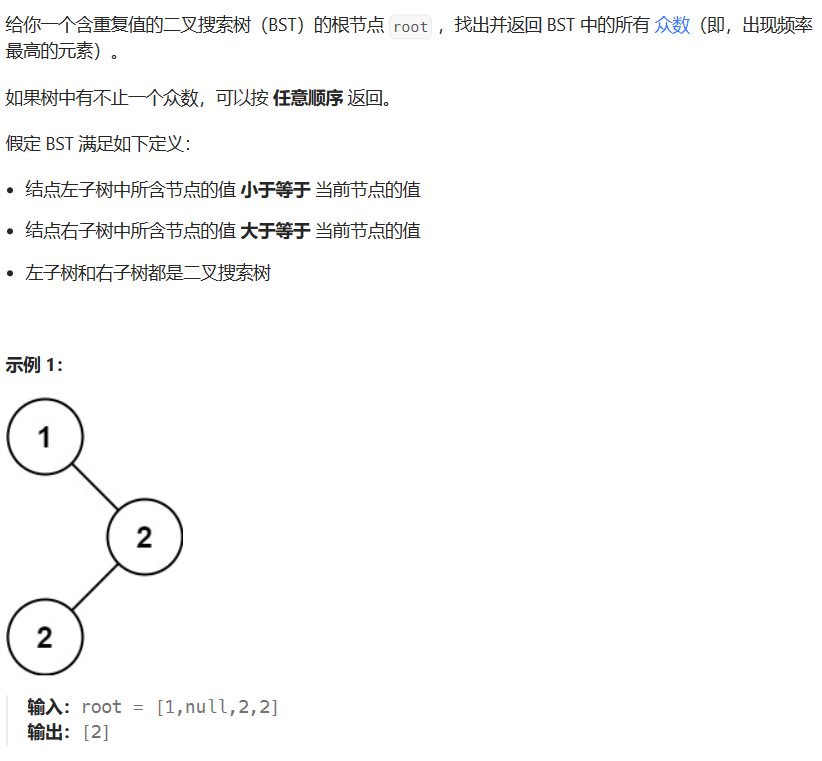
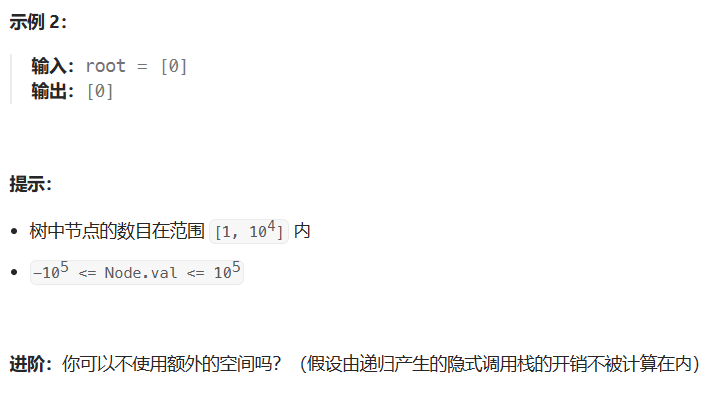
hash通解,即非二叉树也可解
1
2
3
4
5
6
7
8
9
10
11
12
13
14
15
16
17
18
19
20
21
22
23
24
25
26
27
| class Solution {
public:
void Init_um_Recursion(TreeNode* root,unordered_map<int,int>& um)
{
if(!root)
return;
um[root->val]++;
Init_um_Recursion(root->left,um);
Init_um_Recursion(root->right,um);
}
vector<int> findMode(TreeNode* root) {
unordered_map<int,int> um;
Init_um_Recursion(root,um);
vector<int> ans;
int max = INT_MIN;
for(auto& e : um)
if(e.second > max)
max = e.second;
for(auto& e : um)
if(e.second == max)
ans.push_back(e.first);
return ans;
}
};
|
针对
1
2
3
4
5
6
7
8
9
10
11
12
13
14
15
16
17
18
19
20
21
22
23
24
25
26
27
28
29
30
31
32
33
34
35
36
37
38
39
40
41
42
43
44
45
46
47
48
49
50
51
52
53
54
55
56
57
58
59
60
|
class Solution {
public:
int samenum = 0;
int count = 0;
int maxcount = 0;
void Get_ret(TreeNode* root,vector<int>& ret)
{
if(!root)
return;
Get_ret(root->left,ret);
ret.push_back(root->val);
if(samenum == root->val)
count++;
else
{
samenum = root->val;
count=1;
}
if(maxcount < count)
maxcount = count;
Get_ret(root->right,ret);
}
vector<int> findMode(TreeNode* root) {
vector<int> ans;
vector<int> ret;
Get_ret(root,ret);
int left = 0;
int right = maxcount-1;
while(right < ret.size())
{
if(ret[left] == ret[right])
{
ans.push_back(ret[left]);
left = right+1;
right = left+maxcount-1;
}
else
{
left++;
right++;
}
}
return ans;
}
};
|
3.5* 235-二叉搜索树的最近公共祖先
235
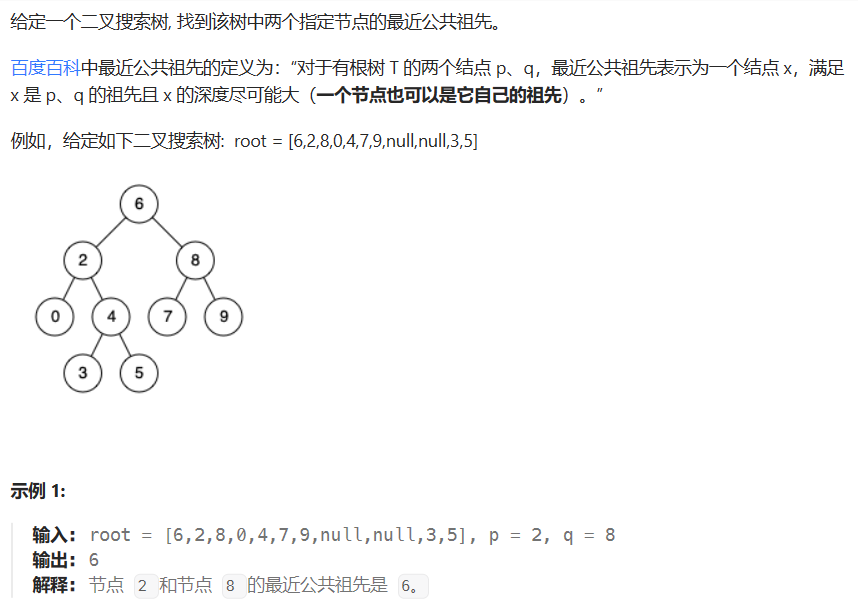

1
2
3
4
5
6
7
8
9
10
11
12
13
| class Solution {
public:
TreeNode* lowestCommonAncestor(TreeNode* root, TreeNode* p, TreeNode* q)
{
if(!root)
return nullptr;
if(root->val > p->val && root->val > q->val)
return lowestCommonAncestor(root->left,p,q);
else if(root->val<p->val&&root->val<q->val)
return lowestCommonAncestor(root->right,p,q);
return root;
}
};
|
3.6* 701-二叉搜索树中的插入操作
701
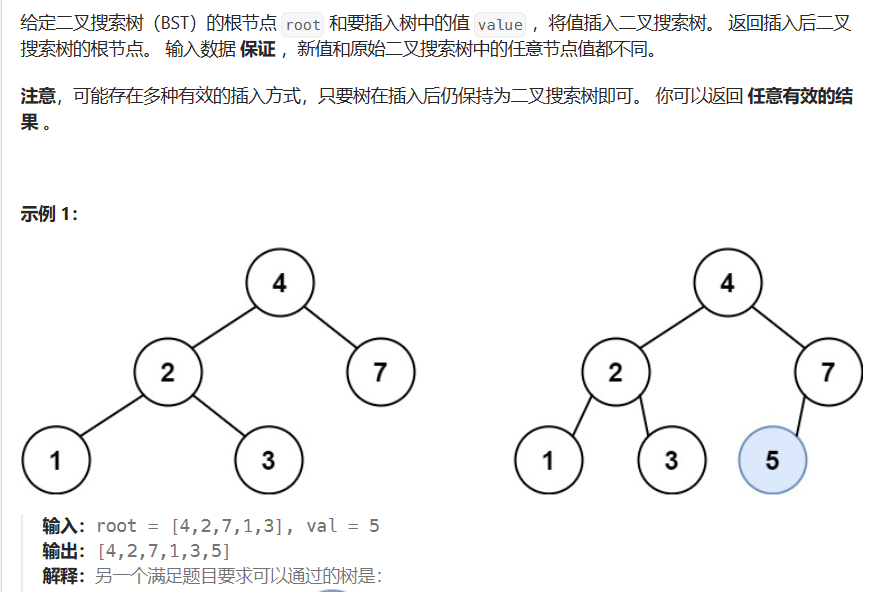
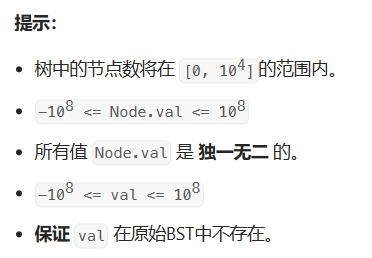
1
2
3
4
5
6
7
8
9
10
11
12
| class Solution {
public:
TreeNode* insertIntoBST(TreeNode* root, int val) {
if(!root)
return new TreeNode(val);
if(val > root->val)
root->right = insertIntoBST(root->right,val);
else if(val < root->val)
root->left = insertIntoBST(root->left,val);
return root;
}
};
|
3.7* 450-删除二叉搜索树中的节点
450
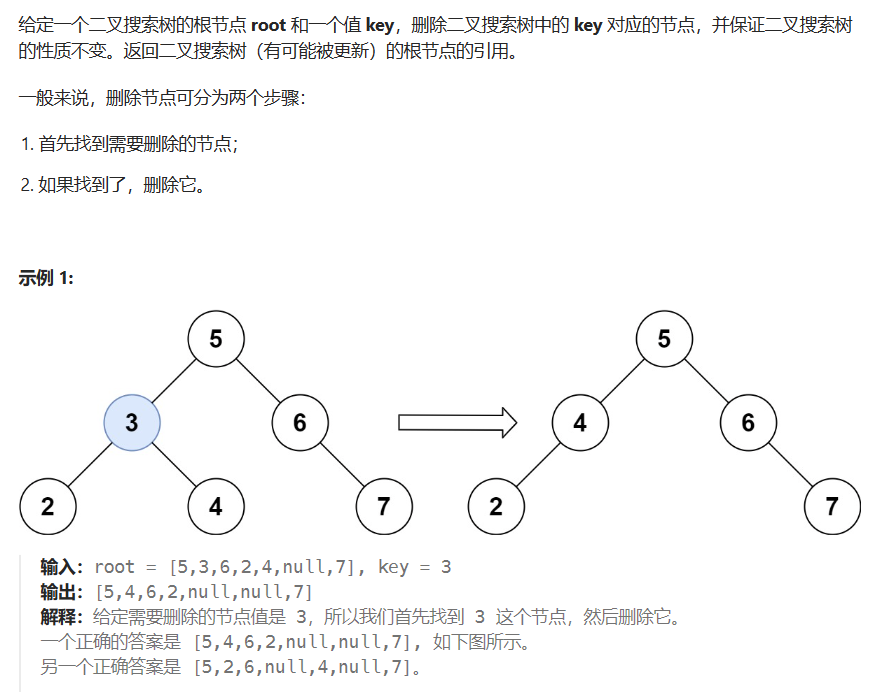
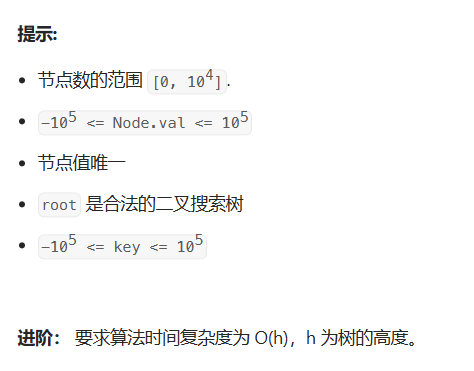
1
2
3
4
5
6
7
8
9
10
11
12
13
14
15
16
17
18
19
20
21
22
23
24
25
26
27
28
29
30
31
32
33
34
35
36
37
38
39
| class Solution {
public:
TreeNode* findMin(TreeNode* node)
{
while (node->left)
node = node->left;
return node;
}
TreeNode* deleteNode(TreeNode* root, int key) {
if (!root)
return root;
if (key < root->val)
root->left = deleteNode(root->left, key);
else if (key > root->val)
root->right = deleteNode(root->right, key);
else
{
if (!root->left)
{
TreeNode* temp = root->right;
delete root;
return temp;
}
else if (!root->right)
{
TreeNode* temp = root->left;
delete root;
return temp;
}
TreeNode* temp = findMin(root->right);
root->val = temp->val;
root->right = deleteNode(root->right, temp->val);
}
return root;
}
};
|
3.8* 669-修剪二叉搜索树
669
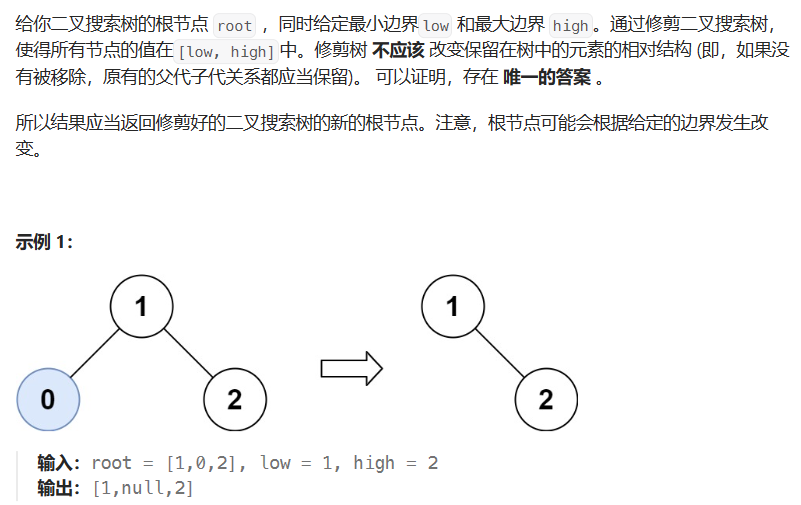
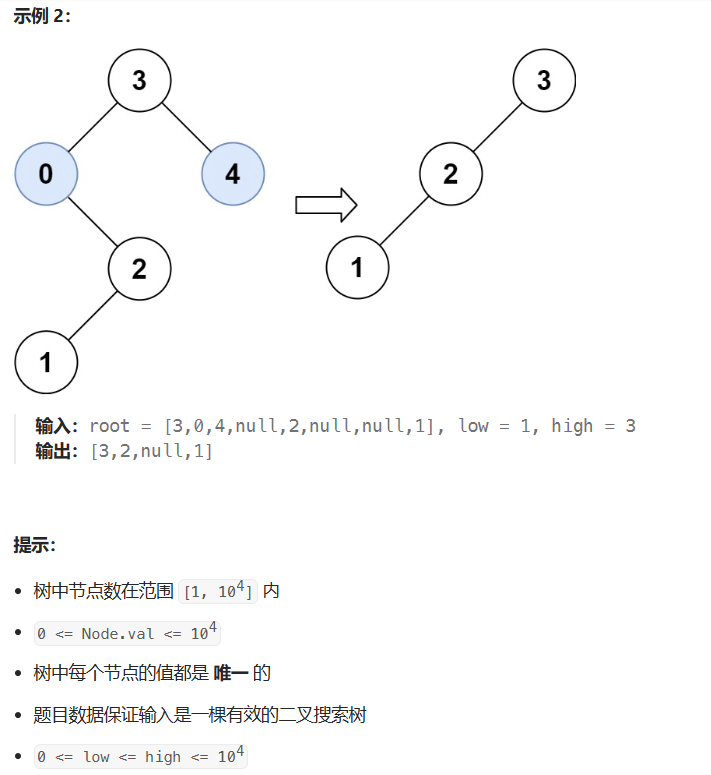
1
2
3
4
5
6
7
8
9
10
11
12
13
14
15
16
| class Solution {
public:
TreeNode* trimBST(TreeNode* root, int low, int high)
{
if(!root)
return nullptr;
if(root->val<low)
return trimBST(root->right,low,high);
if(root->val>high)
return trimBST(root->left,low,high);
root->left = trimBST(root->left,low,high);
root->right = trimBST(root->right,low,high);
return root;
}
};
|
3.9 108-将有序数组转换为二叉搜索树
108
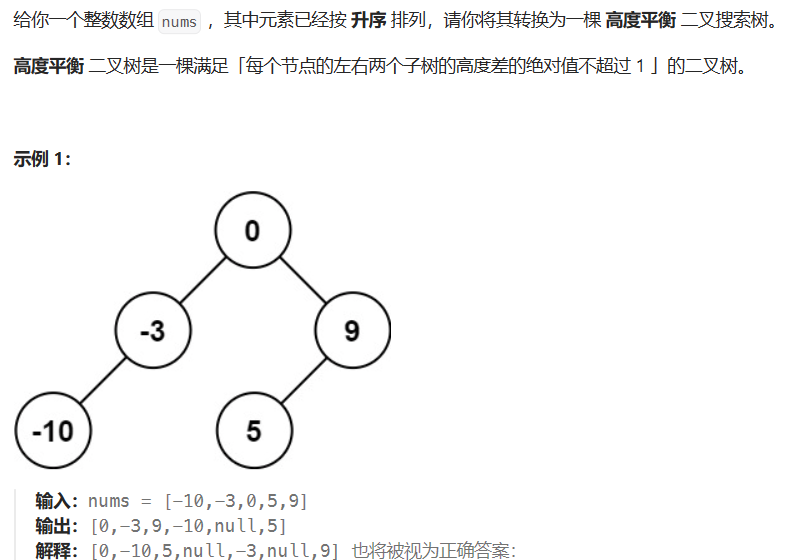
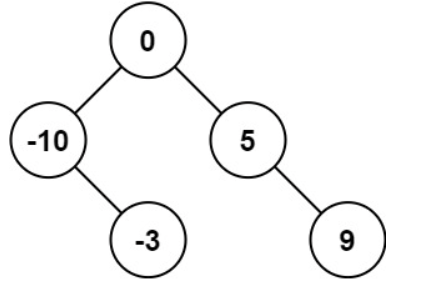
1
2
3
4
5
6
7
8
9
10
11
12
13
14
15
16
17
18
| class Solution {
public:
TreeNode* Recursion(vector<int>& nums,int left,int right)
{
if(left>right)
return nullptr;
int mid = left+((right-left)>>1);
TreeNode* newnode = new TreeNode(nums[mid]);
newnode->left = Recursion(nums,left,mid-1);
newnode->right = Recursion(nums,mid+1,right);
return newnode;
}
TreeNode* sortedArrayToBST(vector<int>& nums)
{
return Recursion(nums,0,nums.size()-1);
}
};
|
3.10 538-把二叉搜索树转换为累加树
538
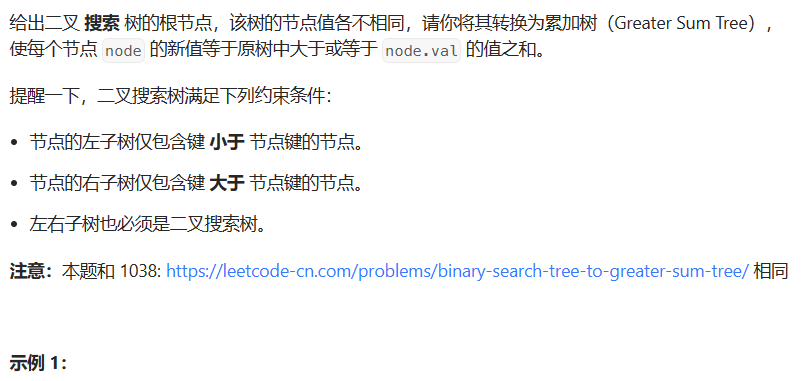
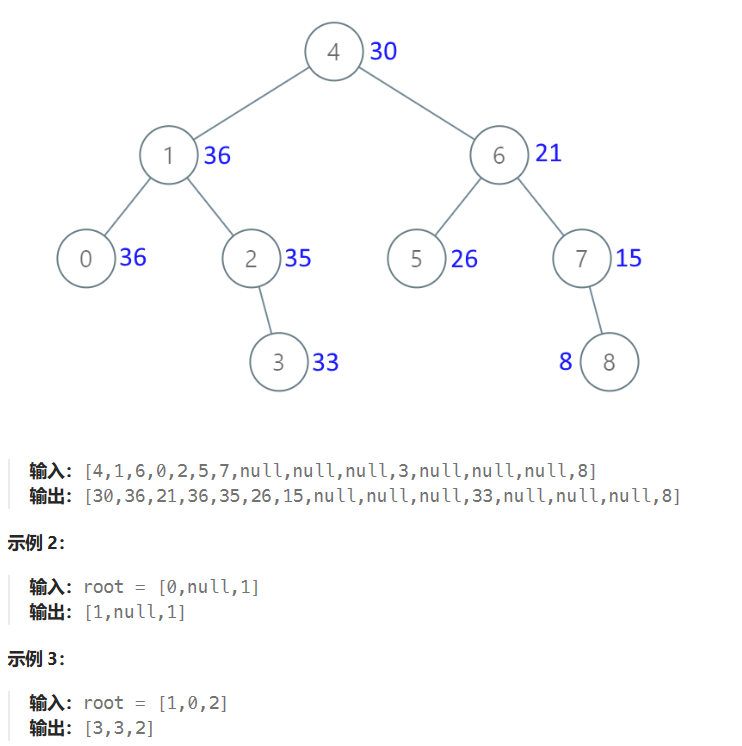
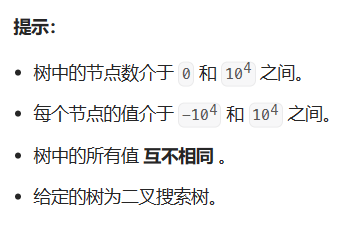
1
2
3
4
5
6
7
8
9
10
11
12
13
14
15
16
17
| class Solution {
public:
void Recursion(TreeNode* root,int& val)
{
if(!root)
return;
Recursion(root->right,val);
val+=root->val;
root->val = val;
Recursion(root->left,val);
}
TreeNode* convertBST(TreeNode* root) {
int val = 0;
Recursion(root,val);
return root;
}
};
|


































































